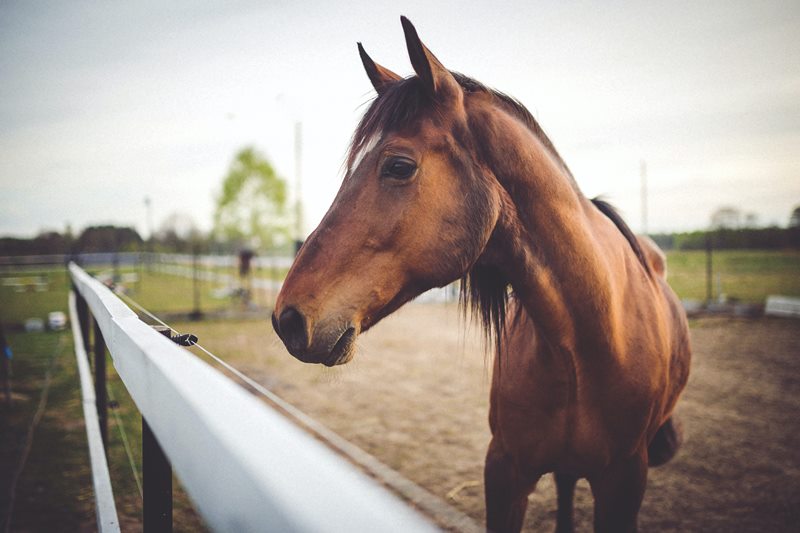
Moving forward from the last article, it is important as an equestrian person, either as a worker, pleasure rider, or horse’s owner to understand how human management affects directly and indirectly to horse’s behaviour, welfare and well-being.
Nowadays, the domestic horse is kept either in single or social housing systems. Some studies in Europe have statistically analysed and found that up to 84% of the total horses are stabled in individual boxes while only 16% are kept in group housing systems .The rationale for this is that horse owners consider this measure to prevent the horses from musculoskeletal injuries associated to fights or play behaviours with other horses, skin and hair damage due to sun bleach or rolling on pasture, and makes the horse easier and safer to handle compared to those living in groups.
A few European countries have recommended a minimum box size for equines in order to prevent welfare issues arising. In Denmark, the surface area should be at least twice the height at the withers squared, with the shortest side of the box being 1.5 times the height at the withers. In the United Kingdom, the British Horse Society recommends a minimum of 3.6 m x 3.6 m box size .
The feral horse has evolved to live within a herd and be in constant movement while grazing and exploring the environment. In order to survive, they have adapted to changes and challenges in nature. However, the performance of most of their biological behaviours are restricted in the stabled horse in comparison to those seen in the wild .The current husbandry practices that the equine industry have imposed to keep horses such as housing conditions, limited exercise and social restrictions, have been shown to dramatically affect their behaviour and inevitably lead to concerns in welfare .
In the horse, locomotory behaviour is linked with the vast majority of its activity. Observations of this behaviour in feral horses revealed that they cover a minimum of 10 km a day depending on season, pasture quality, climatic conditions, and the distance between watering locations .This distance differs considerably with comparisons to domestic horses housed in open barns with a paddock which walk a median of 1.2 km per day or those housed in individual stalls which have been shown to cover as little as 0.17 km per day.
Studies of the confined horse have shown that in stud farms, horses spent an average of 23 h in the stall and were only allowed to move for one hour a day. In another study it was observed that pregnant mares after having been kept for two weeks in straight stalls and then allowed to freely exercise in a paddock, showed more active behaviour such as trotting and galloping to compensate for the exercise deprivation.
Locomotion deficit has been reported to be detrimental for the health of the horse. Studies have shown that lack of movement contributes in addition with feeding deficit to the development of colic ,and musculoskeletal issues such as osteochondrosis in the fetlock in foals. Thus, if the lack of activity is not compensated by additional exercise such as walker or pasture time, further physiological issues such as loss of elasticity in tendons, ligaments and joints may occur, and the self-cleaning mechanism of the respiratory system may get compromised and lead to metabolism impairments.
Literature has also linked housing types with changes in time budget and manageability of horses . When the horse is individually stabled, it has been reported that changes in the behaviour due to the social and locomotory restriction may lead to aggressiveness towards humans. Thus, in another study it was shown that horses became exponentially difficult to handle as the housing treatment became more socially restricted . Finally, other studies have conducted experiments on the influence of bedding material and box size on the time horses spend lying down . Those observations suggested that the horse develops its behaviour in response to the lack of space in the stable. The rolling behaviour is performed as a manoeuvre to ease getting up from recumbent position. This adapted behaviour has raised concerns in terms of welfare as it would not be displayed in the wild and may lead to the horse getting stuck against the wall which increases the risk of injury. Moreover, a small box may affect the time the horse sleeps. While it is not possible to confirm whether the horse is sleeping (REM phase) without a proper analysis, some studies have associated the sleep process with the following purposes, aids the thermoregulatory function, plays a role in memory consolidation,enables vigilance recovery , conserves energy , and is a restorative process.
As it has been summarized, any intervention or human management to the horse may have a great impact on their behaviour, well-being, and ultimately personality development. Being aware of the specific needs that this particular animal has and providing them is the best preventive measure to avoid things going wrong. Happy horse, happy life!
Author: Tamara R.
© EquestrianWork.com - All Rights Reserved
